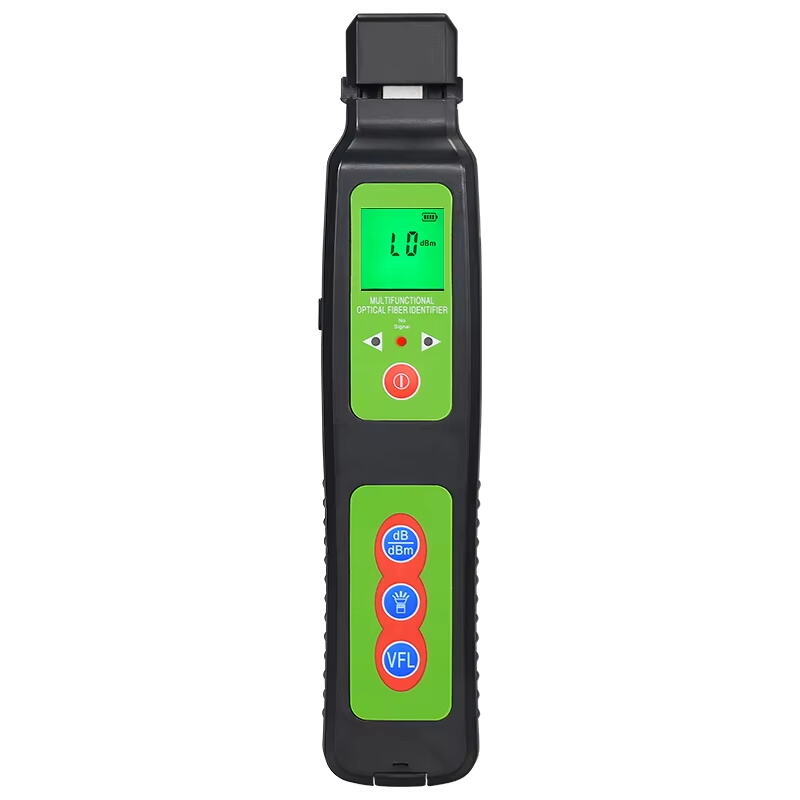নেটওয়ার্ক ট্রাবলশুটিং-এ ফাইবার অপটিক আইডেন্টিফায়ারের পরিচিতি
নেটওয়ার্ক ডায়াগনস্টিক্সের বৃদ্ধি পাওয়া জটিলতা
আজকাল আরও বেশি মানুষ দ্রুত ইন্টারনেট গতি চাওয়ায় আমাদের নেটওয়ার্ক নির্মাণের পদ্ধতি সম্পূর্ণ পরিবর্তিত হয়ে গেছে। আমরা এখন সর্বত্র আরও জটিল পদ্ধতি দেখতে পাচ্ছি, বিশেষ করে ফাইবার অপটিক সংযোগের ক্ষেত্রে। সিসকোর ইন্টারনেট প্রবণতা সম্পর্কিত বার্ষিক প্রতিবেদন অনুসারে, বিশ্বব্যাপী ডেটা ব্যবহার প্রতি বছর প্রায় 20 শতাংশ হারে বৃদ্ধি পাচ্ছে। এর অর্থ হল যে আমাদের নেটওয়ার্কগুলি সময়ের সাথে সাথে আরও বৃহত্তর এবং উন্নত হয়ে উঠছে। এমন প্রসারের সাথে, নেটওয়ার্ক সমস্যা সমাধানের পুরানো পদ্ধতিগুলি আর কার্যকর নয়। আধুনিক সিস্টেমগুলির মধ্যে দিয়ে প্রবাহিত ডেটা পরিচালনা করার জন্য তাদের কাছে যথেষ্ট সজ্জিত নয়। ফাইবার অপটিক্স এর উদাহরণ নিন, কোনও কিছু চালু করার আগে সবকিছু ঠিকঠাক কাজ করছে কিনা তা নিশ্চিত করার জন্য এদের খুব সতর্ক পরীক্ষা এবং পরীক্ষণের প্রয়োজন হয়। এই ধরনের জটিলতা যোগ করার ফলে কোম্পানিগুলির পক্ষে তাদের বর্ধিত অপটিক্যাল নেটওয়ার্ক অবকাঠামো ঠিক রাখতে ভালো ডায়গনস্টিক সরঞ্জামগুলি অত্যন্ত প্রয়োজনীয় হয়ে পড়েছে যাতে পরবর্তীতে কোনও সমস্যা না হয়।
ফাইবার অপটিক আইডেন্টিফায়ার ব্যবহার করে ডায়াগনস্টিক্স সহজ
ফাইবার অপটিক আইডেন্টিফায়ার বা এফওআইগুলি নেটওয়ার্ক ডায়াগনস্টিক্স সহজতর করার জন্য খুব গুরুত্বপূর্ণ হয়ে উঠেছে। প্রযুক্তিবিদদের তাদের সিস্টেমে কোথায় সমস্যা হচ্ছে তা খুঁজে বার করার সময় তারা তাৎক্ষণিক তথ্য পান। এই ডিভাইসগুলি প্রক্রিয়াকে দ্রুত করে তোলে কারণ এগুলি সক্রিয় ফাইবারগুলি চিহ্নিত করতে পারে এবং সমস্যার অবস্থান নির্ণয় করতে পারে যখন নেটওয়ার্ক স্বাভাবিকভাবে চলছে। প্রকৃত পরিস্থিতিতে পরীক্ষায় দেখা গেছে যে জটিল সেটআপগুলির সমস্যা খুঁজে বার করতে এফওআই সময় কমিয়ে দেয়। প্রযুক্তিবিদরা আগের চেয়ে অনেক দ্রুত সমস্যা খুঁজে বার করতে পারেন। পুরো প্রক্রিয়াটি সহজ হয়ে যায় তাই সংশোধনগুলি দ্রুত এবং কম ঝামেলায় হয়ে থাকে। এটি ফাইবার অপটিক নেটওয়ার্ককে দৈনন্দিন ব্যবহারে আরও নির্ভরযোগ্য করে তোলে। বেশিরভাগ প্রতিষ্ঠানই এখন এফওআইকে নেটওয়ার্ক রক্ষণাবেক্ষণের সঙ্গে যুক্ত প্রত্যেককের জন্য অপরিহার্য সরঞ্জাম হিসাবে দেখছে।
ফাইবার অপটিক আইডেন্টিফায়ার ব্যবহারের প্রধান উপকারিতা
চালু ফাইবারের দ্রুত চিহ্নিতকরণ
নেটওয়ার্ক টেকনিশিয়ানরা ফাইবার অপটিক আইডেন্টিফায়ার (এফওআই) -এর উপর বেশি নির্ভর করেন কারণ এই ডিভাইসগুলি তাদের পরিষেবাগুলিতে কোনও বিঘ্ন না ঘটিয়ে সক্রিয় ফাইবার সংযোগগুলি তাৎক্ষণিকভাবে খুঁজে পেতে সাহায্য করে। এগুলি যে গতিতে কাজ করে তা খুবই গুরুত্বপূর্ণ কারণ শিল্প প্রতিবেদন অনুযায়ী প্রতি মিনিটে ব্যবসায়িক ক্ষতি পড়ে প্রায় 5,600 ডলার। যখন এফওআই টেকনিশিয়ানদের দ্রুত সক্রিয় ফাইবারগুলি খুঁজে পেতে সাহায্য করে, তখন ব্যয়বহুল পরিষেবা ব্যহত হওয়া বন্ধ হয়ে যায়। তদুপরি, ডেটা নিরবিচ্ছিন্নভাবে প্রবাহিত করা নেটওয়ার্কগুলিকে দক্ষ রাখে এবং পরিচালন চলাকালীন অপ্রত্যাশিত বিরতি ছাড়াই মসৃণভাবে কাজ করে।
সিগন্যাল ডিটেকশনে উন্নত সঠিকতা
এফওআই-এর সঙ্গে আধুনিক সংকেত সনাক্তকরণ প্রযুক্তি রয়েছে যা ডেটা অখণ্ডতা বজায় রেখে বিভিন্ন ধরনের সংকেত বেছে নিতে পারে। এটির বাস্তব অর্থ হল যখন কিছু ভুল হয় তখন অনেক কম অনুমানের সাহায্যে ভাল নির্ণয়ক ফলাফল পাওয়া যায়। গবেষণায় দেখা গেছে যে পুরানো পদ্ধতির তুলনায় এফওআই প্রায় 60 শতাংশ নির্ভুলতা বাড়ায়, যদিও আসল লাভগুলি পরিস্থিতির উপর নির্ভর করে। নেটওয়ার্ক ম্যানেজারদের জন্য এই উন্নতিগুলি অনেক বেশি গুরুত্বপূর্ণ কারণ এগুলি সিস্টেমগুলিকে মসৃণভাবে চালাতে সাহায্য করে এবং পরীক্ষার পর্যায়ে ঘটিত হওয়া বিরক্তিকর ত্রুটিগুলি কমিয়ে দেয়।
অক্ষতা চিহ্নিতকরণে সময়ের দক্ষতা
ফিল্ড অপারেশনস ইন্টারফেস (এফওআই) এর একটি প্রধান সুবিধা হল কম সময়ে ত্রুটি খুঁজে পাওয়া। এই সিস্টেমগুলি সমস্যা দ্রুত চিহ্নিত করা অনেক সহজ করে তোলে, যার ফলে কম সময় বন্ধ থাকা এবং সমস্যা সমাধানে কম সময় লাগে। উদাহরণ হিসাবে বাস্তব পরিস্থিতি বিবেচনা করা যাক। এফওআই দিয়ে কাজ করা প্রযুক্তিবিদদের প্রায়শই এক ঘণ্টার কম সময়ের মধ্যে নেটওয়ার্কের সমস্যা খুঁজে বার করতে দেখা যায়, যেখানে এফওআই ছাড়া একই ধরনের কাজ ঘণ্টার পর ঘণ্টা সময় নিতে পারে। সময়ের এই সাশ্রয় অত্যন্ত গুরুত্বপূর্ণ কারণ এর ফলে কম পরিষেবা বন্ধ থাকে এবং নেটওয়ার্কের মোটের উপর নির্ভরযোগ্যতা বৃদ্ধি পায়, বিশেষ করে সেইসব অবকাঠামো পরিচালকদের কাছে যাদের পক্ষে দীর্ঘ সময় ধরে ব্যাহত হওয়া সম্ভব নয়।
নেটওয়ার্ক ইন্টিগ্রিটির জন্য অ-অবনাশক পরীক্ষা
সমস্যা নির্ণয় করার সময় FOIs প্রকৃত হার্ডওয়্যারের সাথে হস্তক্ষেপ করে না, তাই ডায়াগনিস্টিক প্রক্রিয়া জুড়ে নেটওয়ার্কগুলি অক্ষুণ্ণ থাকে। এই সরঞ্জামগুলি তাদের জাদু কাজ করে সেই সূক্ষ্ম ফাইবার অপটিক ক্যাবলগুলিকে স্পর্শ না করেই, যার অর্থ হল ক্ষতি বা ক্ষতির আরও বড় ঝুঁকি নেই। প্রযুক্তিগত বিশেষজ্ঞদের মতে এটি কতটা গুরুত্বপূর্ণ তা তারা সবাই জোর দিয়ে বলেন কারণ একবার কিছু ভৌতভাবে ক্ষতিগ্রস্ত হয়ে গেলে ডেটা ঠিকঠাক মতো প্রবাহিত হওয়া বন্ধ করে দেয় এবং এটি মেরামত করা অনেক বেশি খরচ হয়। আমরা সবাই দেখেছি যখন একটি ছোট ক্ষত পরবর্তী সময়ে একটি প্রধান মাথাব্যথায় পরিণত হয়।
ফাইবার অপটিক আইডেন্টিফায়ার কিভাবে কাজ করে
অয়ন-আক্রমণী নির্দেশনা জন্য ম্যাক্রো-বেন্ডিং প্রযুক্তি
ফাইবার অপটিক আইডেন্টিফায়ার বা এফওআইগুলি ম্যাক্রো-বেন্ডিং প্রযুক্তি নামে কিছু ব্যবহার করে, যা ফাইবারগুলি স্পর্শ না করেই সেগুলো পরীক্ষা করার জন্য খুব গুরুত্বপূর্ণ। এখানে যা ঘটে তা যথেষ্ট সহজ: যখন আমরা ফাইবার ক্যাবলটি মৃদুভাবে ঠিক মতো বাঁকাই, কোরের অভ্যন্তর থেকে কিছু আলো নির্গত হয় এবং আমাদের সনাক্তকরণ সরঞ্জামগুলি এটি ধরে ফেলে। এই পদ্ধতির সুবিধা কী? তারা যে ডেটা আসলে ফাইবারের মধ্যে দিয়ে প্রবাহিত হচ্ছে কিনা তা নির্ধারণ করতে পারে ক্যাবলটি কাটা ছাড়াই বা নেটওয়ার্কের অন্য কিছু বন্ধ করার প্রয়োজন নেই। এর অর্থ হল কোনও ডাউনটাইম নেই এবং সিস্টেমগুলি মসৃণভাবে চলতে থাকে। ঐতিহ্যবাহী পদ্ধতিগুলি প্রায়শই ক্যাবলগুলি কাটার প্রয়োজন হয়, যা স্পষ্টতই সংযোগগুলির উপর নির্ভরশীলদের জন্য সমস্যা সৃষ্টি করে। যাইহোক, ম্যাক্রো-বেন্ডিংয়ে প্রায় কোনও ঝুঁকি নেই। এছাড়াও, এই সরঞ্জামগুলি বর্তমান নেটওয়ার্ক সেটআপগুলির সাথে দুর্দান্তভাবে কাজ করে তাই কোম্পানিগুলির পুরো অবকাঠামো পুনরায় লেখা ছাড়াই ভাল ডায়গনস্টিক্স পেতে অসংখ্য অর্থ ব্যয় করার দরকার হয় না।
সিগন্যাল দিক এবং ট্রাফিক বিশ্লেষণ
FOI-গুলি কেবল সমস্যাগুলি শনাক্ত করে না কিন্তু সংকেতগুলি কোথায় যাচ্ছে এবং কত পরিমাণ ট্রাফিক চলছে তার মূল্যবান তথ্য দেয়। নেটওয়ার্ক ম্যানেজাররা তাদের ফাইবার লাইনের মধ্যে দিয়ে কত পরিমাণ ডেটা প্রবাহিত হচ্ছে তা সঠিকভাবে ট্র্যাক করতে পারেন এবং দেখতে পাবেন যে ডেটা কোথায় যাচ্ছে। এটি তাদের নিশ্চিত করতে সাহায্য করে যাতে সবকিছু মসৃণভাবে চলে এবং সমস্যার সমাধান করা যায় যেখানে অতিরিক্ত ডেটা ভবিষ্যতে সমস্যা তৈরি করতে পারে। গবেষণায় দেখা গেছে যে যখন কোম্পানিগুলি FOI-সহ এই ধরনের ট্রাফিক বিশ্লেষণ সরঞ্জামগুলি ব্যবহার শুরু করে, তখন তারা সাধারণত ব্যান্ডউইথের উপর ভালো নিয়ন্ত্রণ এবং গ্রাহকদের জন্য উন্নত পরিষেবা পায়। ডেটা প্রবাহের ম্যাপ তৈরি করা টেকনিশিয়ানদের সমস্যাগুলি আগেভাগেই খুঁজে পাওয়ার প্রবণতা থাকে। তারা এমনকি কোনও সমস্যা লক্ষ্য করার আগেই তা ঠিক করতে পারে, যা নেটওয়ার্কগুলিকে প্রায়শই সর্বোচ্চ কর্মক্ষমতায় চালাতে সাহায্য করে।
বাস্তব-সময়ে ডেটা চিত্রণ এবং ব্যাখ্যা
অপটিক্যাল ফাইবার আইডেন্টিফায়ারগুলি নেটওয়ার্ক ম্যানেজারদের বাস্তব সময়ের চিত্র সরবরাহ করে যা নেটওয়ার্ক সমস্যা সম্পর্কে সিদ্ধান্ত নেওয়ার সময় পার্থক্য তৈরি করে। যখন এই সিস্টেমগুলি কাঁচা ডেটার পাহাড়কে কোনও কিছুতে রূপান্তর করে যা মানুষ চোখ বন্ধ করে দেখতে এবং বুঝতে পারে, তখন প্রযুক্তিবিদদের সংখ্যাগুলির অর্থ বোঝার জন্য অনেক কম সময় কাটাতে হয়। শিল্পের অধিকাংশ মানুষই দেখেন যে যখন তারা নেটওয়ার্ক পারফরম্যান্স গভীরভাবে দেখার জন্য উদ্দিষ্ট কিছু অত্যন্ত উন্নত সফটওয়্যার প্যাকেজের সাথে এই আইডেন্টিফায়ারগুলি সংযুক্ত করেন তখন সবকিছু ঠিকঠাক হতে শুরু করে। এই সংমিশ্রণটি নেটওয়ার্ক ম্যানেজারদের তাৎক্ষণিকভাবে ব্যবহারযোগ্য তথ্য দেয়, যাতে সমস্যাগুলি দ্রুত সমাধান হয় এবং ভবিষ্যতের প্রসারের পরিকল্পনাগুলি আরও যৌক্তিক হয়। এই ধরনের সরঞ্জামগুলিকে মূলত সম্পূর্ণ নেটওয়ার্কের জন্য একটি নিয়ন্ত্রণ প্যানেল হিসাবে ভাবুন, যা নিয়ত দেখায় কোথাও ব্যর্থ হচ্ছে বা অদ্ভুতভাবে আচরণ করছে। এই ধরনের নিয়মিত পর্যবেক্ষণের মাধ্যমে সমস্ত কিছু মসৃণভাবে চলতে থাকে এবং কেউ কারও প্রতিটি উপাদানের পাশে ঘন্টার পর ঘন্টা তত্ত্বাবধান করার প্রয়োজন হয় না।
নিষ্কর্ষ: ফাইবার অপটিক আইডেন্টিফায়ার ব্যবহার করে নেটওয়ার্ক রক্ষণাবেক্ষণ অপটিমাইজ করুন
ভবিষ্যদ্বাণী নেটওয়ার্ক ডায়াগনস্টিক্স
ফাইবার অপটিক আইডেন্টিফায়ার (এফওআই) নেটওয়ার্ক সিস্টেমে যোগ করা যুক্তিযুক্ত হয়ে ওঠে যদি কোম্পানিগুলি চায় যে তাদের নেটওয়ার্কগুলি ভবিষ্যতের পরিবর্তনগুলি সহ্য করতে পারুক। এই আইডেন্টিফায়ারগুলি নেটওয়ার্ক রক্ষণাবেক্ষণের সময় কারিগরদের কাজকে আরও উন্নত করতে সাহায্য করে, এছাড়াও তারা প্রযুক্তিগত উন্নয়নের সাথে সাথে এবং সিস্টেমগুলির মধ্য দিয়ে প্রবাহিত তথ্যের পরিমাণ বৃদ্ধির সাথে খাপ খাইয়ে নিতে সক্ষম। এফওআইগুলি সমস্যা দ্রুত সমাধানে সহায়তা করে এবং নতুন প্রযুক্তির পাশাপাশি কাজ করে যাতে নেটওয়ার্কগুলি ট্রাফিক বৃদ্ধির পরেও শক্তিশালী থাকে। শিল্পমহলে সম্প্রতি একটি আকর্ষণীয় বিষয় লক্ষ্য করা হয়েছে - আরও বেশি সংখ্যক কোম্পানি এমন সরঞ্জামগুলির দিকে তাকাচ্ছে যা শুধুমাত্র সমস্যা সমাধান করে না বরং সমস্যা দেখা দেওয়ার আগেই তা ভবিষ্যদ্বাণী করতে সক্ষম। এটিই হল কারণ যার জন্য এফওআই এখন জনপ্রিয়তা লাভ করছে। প্রযুক্তি যত দ্রুত এগিয়ে যাচ্ছে, ব্যবসাগুলির কাছে আরও ভালো সরঞ্জামের প্রয়োজন হচ্ছে যা নিরবিচ্ছিন্নভাবে সবকিছু মসৃণভাবে চালিত রাখতে সাহায্য করবে এবং প্রায়শই ব্যর্থতা এড়াবে।
অগ্রগামী সমস্যা সমাধানের মাধ্যমে খরচ বাঁচানো
ফাইবার অপটিক আইডেন্টিফায়ারগুলি নেটওয়ার্কের সমস্যাগুলি প্রধান সমস্যায় পরিণত হওয়ার আগে সেগুলি ঠিক করার ক্ষেত্রে খরচ কমাতে প্রকৃতপক্ষে অনেক সাহায্য করে। এই আইডেন্টিফায়ারগুলি যখন সমস্যাগুলি সনাক্ত করে তখন কোম্পানিগুলি কম অপ্রত্যাশিত বন্ধের এবং কম গুরুতর ক্ষেত্রে সেগুলি দেখতে পায়। মূল কথা হল: মেরামতির জন্য অপেক্ষা করা সময় কম হওয়ায় অর্থ সাশ্রয় হয়। কয়েকটি টেলিকম সংস্থার আর্থিক প্রতিবেদনগুলি প্রকৃতপক্ষে এই প্রযুক্তি প্রয়োগের পর সময়ের সাথে সাথে বেশ কিছু অভিন্ন সাশ্রয় দেখায়। এই সাশ্রয়গুলির অধিকাংশই আসে ভালো ডায়গনোস্টিক সরঞ্জাম এবং বুদ্ধিদীপ্ত রক্ষণাবেক্ষণ পদ্ধতির মাধ্যমে যা নেটওয়ার্কে টেকনিশিয়ানদের অপ্রয়োজনীয় সমস্যার পিছনে ছুটে বেড়ানো থেকে বিরত রাখে। বৃহৎ পরিসরে নেটওয়ার্ক পরিচালনাকারী ব্যবসাগুলির পক্ষে FOI-এ বিনিয়োগ করা আর্থিক এবং পরিচালনাগতভাবেই যৌক্তিক। আমরা যেসব IT ম্যানেজারদের সাথে কথা বলেছি তাদের অধিকাংশই বলেছেন যে এই পদ্ধতি গ্রহণের পর থেকে তাদের নেটওয়ার্কগুলি আরও মসৃণ এবং নির্মলভাবে চলছে, যা এমন একটি শিল্পে তাদের মানসিক শান্তি দিয়েছে যেখানে ডাউনটাইমের প্রতিটি মিনিট প্রকৃত অর্থ খরচ করে।
FAQ
ফাইবার অপটিক আইডেন্টিফায়ার কি?
ফাইবার অপটিক আইডেন্টিফায়ার হল ডায়াগনস্টিক টুল যা সেবা ব্যাঙ্ক ছাড়াই জীবন্ত ফাইবার কানেকশন ও নেটওয়ার্ক সমস্যা নির্ধারণে ব্যবহৃত হয়।
এফওআই গুলি নেটওয়ার্ক ট্রাবলশুটিং কে কিভাবে উন্নত করে?
এফওআই গুলি জীবন্ত ফাইবার চিহ্নিত করার এবং অজুহাতপূর্বক ত্রুটি নির্ধারণের মাধ্যমে নেটওয়ার্ক ডায়াগনস্টিক্স সহজতর করে, যা ডাউনটাইম কমায় এবং সঠিকতা বাড়ায়।
এফওআই গুলি কোন প্রযুক্তি ব্যবহার করে?
এফওআই গুলি অজুহাতপূর্বক ত্রুটি নির্ণয়ের জন্য ম্যাক্রো-বেন্ডিং প্রযুক্তি ব্যবহার করে, যা তেকনিশিয়ানদের নেটওয়ার্ককে ব্যাহত করা ছাড়াই ডায়াগনস্টিক্স করতে দেয়।
এফওআই গুলি কেন লাগনি-কার্যকর বলে বিবেচিত হয়?
এফওআই গুলি প্রাক্তনিক ট্রাবলশুটিং এর মাধ্যমে খরচ কমায়, যা কম অপ্রত্যাশিত বন্ধ হওয়ার এবং কম রক্ষণাবেক্ষণের খরচের কারণে নেটওয়ার্ক ইনফ্রাস্ট্রাকচারের আর্থিক বিনিয়োগ অপটিমাইজ করে।







